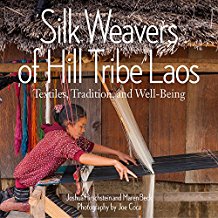Maren and I never chose to be textile enthusiasts or authors, of Laos or anywhere else. Nor was this destiny inherited, or even anticipated. We kind of just . . . uh . . . followed our curiosity.
Cultural Adventures
We began our adult lives together as cultural adventurers, not textile enthusiasts, and many highlights of our 34 years (and two children) together involve backpacks and rural Asia. Our curiosity about how others lived, especially those with fewer modern amenities, has always fueled our itch to explore. We also reveled in the stories—and bonds—that such adventures create.

Xam Tai’s beautiful valley. Photo by Josh and Maren from Silk Weavers of Hill Tribe Laos.
However, our first visit in 2007 to the extraordinary silk-weaving village of Xam Tai in Laos’s remote northeast corner (told in our book’s first chapter) portended a new direction for adventuring, as a door was opened that allowed us to delve deeper. This time our curiosity welled from a different fount, and it propelled us seek not a broad experience, but rather the details of a people and their incredible textile-based culture: How does Seuk raise the silkworms, and reel their filaments? How does Souksakone, the dyer, extract the red from the excretion of a scale bug? How do the mechanics of the clever “supplemental heddle system” on Phout’s hand-built loom create and save the complex patterns? What are the meanings behind the other-worldly motifs on Lun’s healing cloth?

Seuk reeling silk from the steaming water in the reeling pot. Photo by Joe Coca from Silk Weavers of Hill Tribe Laos.
Our experiences, research, and developing relationships eventually pursued more profound questions as well: How does this unique and intricate textile art, which dates back to the dawn of the culture, support the economic and spiritual well-being of the region’s people? How does it transmit their inherited cultural knowledge? How did this textile tradition come to be? How are the art and people reacting to today’s rapid modernization? What does the future hold?
Maren and I also have come to understand that the more we learn, the more timeless and relevant the story of these traditional weavers and their art reveals itself to be.
Cultural Celebration
Upon reading Silk Weavers of Hill Tribe Laos last month, my brother expressed surprise—and gratitude—that our “textile book” shared stories and personalities. He commented that he truly felt like he was “soaking up the village scene” and sharing time with the locals, which in turn made their history and art seem that much more approachable. The following week Maren’s mom, past president of the Seattle Weaver’s Guild, expressed appreciation for our meticulous descriptions of the silk raising, weaving, and dyeing processes and the depth of ethno-historical information. She was drawn to our book’s precise and supportive detail.

Phout of Xam Tai at her loom. Photo by Joe Coca from Silk Weavers of Hill Tribe Laos.
Our publisher, Linda Ligon, wrote last month in “Weaving off the Beaten Path” that we had told her we wanted to author a book that “would not be like any other book Thrums had ever published.” (Thanks for being undaunted, Linda!) That is, we wanted a fun-edged telling that introduces story and personalities to lure the cultural enthusiast and armchair traveler into the ever-more-tantalizing details (just as we were pulled in). We also wanted to present clear and relevant facts and description to satisfy the punctilious textile enthusiast, while still intriguing that reader with a rich and supportive cultural experience. We wanted a book that engaged the curiosity of both my brother and Maren’s mom.
We also wanted a book—and here we can celebrate the entire line of Thrums Books publications—that supports the relationship between culture and craft, craft and artist, artist and appreciator (i.e. the marketplace), and appreciator and culture, as the health of this cycle ensures the relevance and vitality of human creativity and traditional arts. So a special thank you to Thrums Books, for allowing us an opportunity to share a tale of a most amazing people and their inherited art-form.
We hope everyone enjoys the story. Oh, and the details, too!

The cover of our publication, now available (autographed!) at www.hilltribeart.com or your favorite bookstore.
